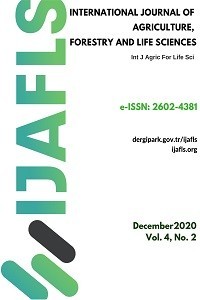EFFECTS OF VERMICAST APPLICATION TO THE GROWTH AND SURVIVAL OF BITANGHOL (Calophyllum blancoi Pl. and Tr.) IN GRASSLAND
EFFECTS OF VERMICAST APPLICATION TO THE GROWTH AND SURVIVAL OF BITANGHOL (Calophyllum blancoi Pl. and Tr.) IN GRASSLAND
Vermicast, Calophyllum blancoi, growth survival, reforestation,
___
- Angeles, L. and F. Tamolang. 1963-1964. Fertilization of forest lands in the Philippines. Phil. Lumber 10 (1): pp 74.
- Atiyeh, R., S. Subler, C. Edwards, and J. Metzger. 1999. Earthworms in agroecosystems and land use-Growth of tomato plants in horticultural potting media amended with vermicompost. Pedobiologia. 43(6):724-728.
- Bumatay, E. 1984. Effects of Fertilization on the Growth and Survival of Giant Ipil-ipil (Leucaena leucocephala (Lam.) de Wit) and Agoho (Casuarina equisetifolia Forst.) Seedlings Outplanted in Grassland in Selected Site of Region VII and Region VIII. Unpublished manuscript.
- Chaoui, H. 2010. Vermicasting (or Vermicomposting): Processing organic wastes through earthworms. Factsheet.1-7.
- Cular, J. 1999. Grassland Communities in elevated limestone hills of Minglanilla, Cebu. (Unpublished undergraduate thesis). Visca, Baybay, Leyte.
- DENR, 2011. Executive Order No. 26, February 24, 2011 Official Gazette Vol.106, No.23 pp.3195
- Lamanilao, J. 1991. The national forestry program and its technology needs. PCARRD Book Series 121:22-24.
- Morarka, M. 2008. Vermiculture - Applications and Benefits GDC Rural Research Foundation, Rajasthan India.
- Sinha R., S. Herat, D .Valani, K. Chauhan. 2009. Vermiculture and sustainable agriculture; American-Eurasian J. Agric. Environ. Sci.; IDOSI Publication (www.idosi.org.)(Special Issue); ISSN 1818: 5 (S); pp. 01- 55;
- Sungthongwises K. 2015. Efficiency of Vermicompost on Growth and Nutrients Content of Young Rubber Trees (Hevea brasiliensis). International Journal of Environmental and Rural Development. 6-1.
- Yayın Aralığı: Yılda 2 Sayı
- Başlangıç: 2017
- Yayıncı: Volkan OKATAN
INVESTIGATIONS ON SOME PROPERTIES OF CURRANT AND GOOSEBERRY VARIETIES GROWN IN ORGANIC CONDITION
POLYGENIC RESISTANCE OF IMPROVED RED PEPPER LINES TO PHYTOPHTHORA CAPSICI
Saadet Toğaç, Sermin Akıncı, Bekir Bülent Arpacı
Yasemin KARAFAKIOGLU, Laçine AKSOY
DETERMINATION OF SUITABLE AREAS OF APPLE (MALUS DOMESTICA) CULTIVATION WITH AHP AND GIS TECHNIQUES
Namık Kemal SÖNMEZ, Sahriye SÖNMEZ, Mesut ÇOŞLU, Hasan Raşit TÜRKKAN
EFFECTS OF CALCIUM ASCORBATE AND CALCIUM LACTATE ON QUALITY OF FRESH-CUT PINEAPPLE (Ananas comosus)
Roden TROYO, Antonio Jr. ACEDO
THE USING OF TREES IN HITTITE RELIGIOUS RITUALS
FERTILIZER INPUTS IMPACT OF DIFFERENT BIO-SOLID SOURCES ON SUGAR BEET YIELD IN SANDY SOIL
Ezzat ABD EL LATEEF, Mostafa ABD EL-SALAM, Aziza FARRAG, Gehan AMİN
EFFECT OF SEAWEED EXTRACT (SE) ON SEED GERMINATION CHARACTERISTICS OF WHEAT IN SALTY CONDITIONS
